The AMD Threadripper 2990WX 32-Core and 2950X 16-Core Review
by Dr. Ian Cutress on August 13, 2018 9:00 AM ESTHEDT Benchmarks: Encoding Tests
With the rise of streaming, vlogs, and video content as a whole, encoding and transcoding tests are becoming ever more important. Not only are more home users and gamers needing to convert video files into something more manageable, for streaming or archival purposes, but the servers that manage the output also manage around data and log files with compression and decompression. Our encoding tasks are focused around these important scenarios, with input from the community for the best implementation of real-world testing.
Handbrake 1.1.0: Streaming and Archival Video Transcoding
A popular open source tool, Handbrake is the anything-to-anything video conversion software that a number of people use as a reference point. The danger is always on version numbers and optimization, for example the latest versions of the software can take advantage of AVX-512 and OpenCL to accelerate certain types of transcoding and algorithms. The version we use here is a pure CPU play, with common transcoding variations.
We have split Handbrake up into several tests, using a Logitech C920 1080p60 native webcam recording (essentially a streamer recording), and convert them into two types of streaming formats and one for archival. The output settings used are:
- 720p60 at 6000 kbps constant bit rate, fast setting, high profile
- 1080p60 at 3500 kbps constant bit rate, faster setting, main profile
- 1080p60 HEVC at 3500 kbps variable bit rate, fast setting, main profile
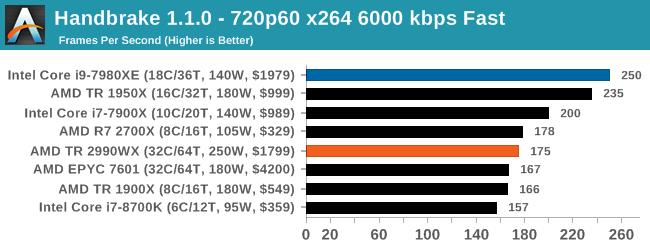
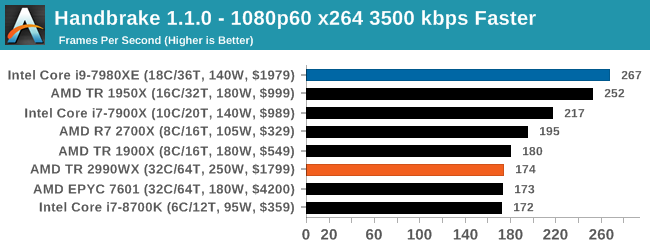
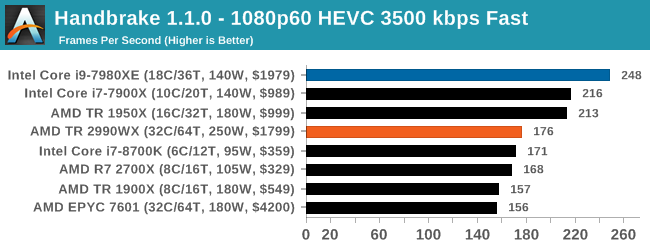
Video encoding is always an interesting mix of multi-threading, memory latency, and compute. The Core i9, with AVX2 instructions, sets a commanding lead in all three tests. The AMD processors seem to fluctuate a bit, with the 1950X and 2700X being the best of the bunch. Unfortunately we didn’t get 2950X results in our initial runs, but I would expect it to be competitive with the Core i9 for sure, given where the 1950X is. However the 2990WX does fall behind a bit.
7-zip v1805: Popular Open-Source Encoding Engine
Out of our compression/decompression tool tests, 7-zip is the most requested and comes with a built-in benchmark. For our test suite, we’ve pulled the latest version of the software and we run the benchmark from the command line, reporting the compression, decompression, and a combined score.
It is noted in this benchmark that the latest multi-die processors have very bi-modal performance between compression and decompression, performing well in one and badly in the other. There are also discussions around how the Windows Scheduler is implementing every thread. As we get more results, it will be interesting to see how this plays out.
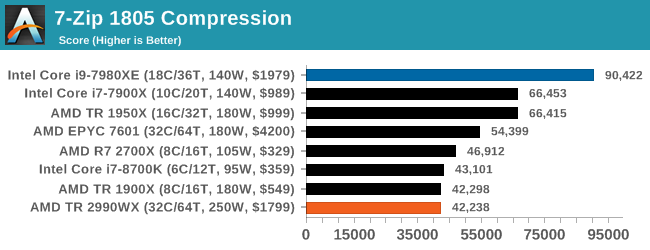
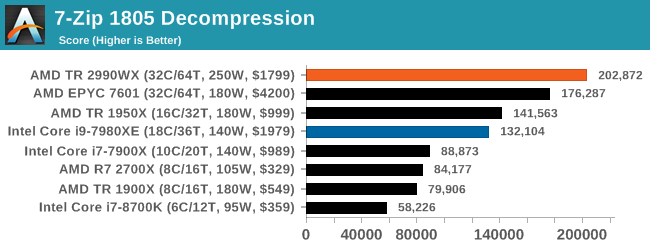
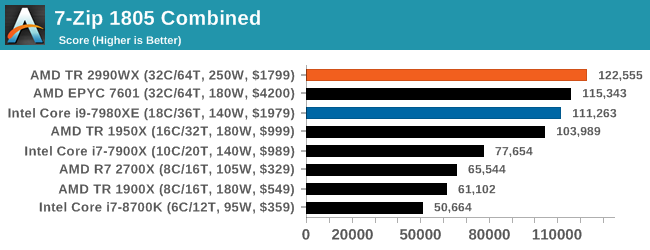
Oh boy, this was an interesting set of tests. When we initially published this review, without commentary, the compression graph with the 2990WX at the bottom was shared around social media like crazy, trying to paint a picture of why AMD performance isn’t great. It was also used in conjuction with Phoronix’s tests, that showed a much better picture on Linux.
But what confuses me is that almost no-one also posted the decompression graph. Here AMD’s 32-core processors take a commanding lead, with the 16/18-core parts being the best of the rest.
If you plan to share out the Compression graph, please include the Decompression one. Otherwise you’re only presenting half a picture.
WinRAR 5.60b3: Archiving Tool
My compression tool of choice is often WinRAR, having been one of the first tools a number of my generation used over two decades ago. The interface has not changed much, although the integration with Windows right click commands is always a plus. It has no in-built test, so we run a compression over a set directory containing over thirty 60-second video files and 2000 small web-based files at a normal compression rate.
WinRAR is variable threaded but also susceptible to caching, so in our test we run it 10 times and take the average of the last five, leaving the test purely for raw CPU compute performance.

A set of high frequency cores and good memory is usually beneficial, but sometimes some more memory bandwidth and lower latency helps. At the top is AMD’s R7 2700X, with the Intel 10-core just behind. I’m surprised not to see the 8700K in there, perhaps its six cores is not enough. But the higher core count AMD parts struggle to gain traction here, with the 32-core parts taking some sweet time to finish this test.
AES Encryption: File Security
A number of platforms, particularly mobile devices, are now offering encryption by default with file systems in order to protect the contents. Windows based devices have these options as well, often applied by BitLocker or third-party software. In our AES encryption test, we used the discontinued TrueCrypt for its built-in benchmark, which tests several encryption algorithms directly in memory.
The data we take for this test is the combined AES encrypt/decrypt performance, measured in gigabytes per second. The software does use AES commands for processors that offer hardware selection, however not AVX-512.
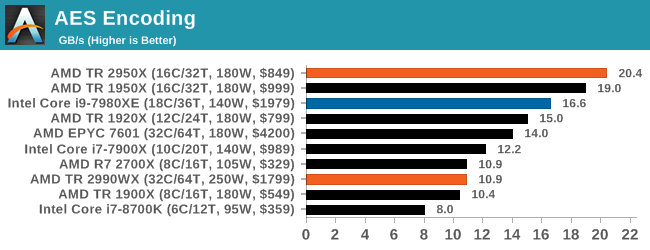
Normally we see this test go very well when there are plenty of cores, but it would seem that the bi-modal nature of the cores and memory controllers in the 2990WX gives a poor result. The EPYC 7601, with eight memory controllers, does a better job, however the 1950X wins here. The 2950X, where all cores have a similar access profile, scores top here, well above Intel’s 18-core Core i9.










171 Comments
View All Comments
Eastman - Tuesday, August 14, 2018 - link
Just a comment regarding studios and game developers. I work in the industry and 90% of these facilities do run with Xeon workstations and ECC memory. Either custom built or purchased from the likes of Dell or HP. So yes, there is a market place for workstations. No serious pro would do work on a mobile tablet or phone where there is a huge market growth. There is definitely a place for a single 32 core CPUs. But among say 100 workstations there might be a place for only 4-5 of the 2990WX. Those would serve particles/fluids dynamics simulation. Most of the workload would be sent to render farms sometimes offsite. Those render farms could use Epyc/Xeon chips. If I was a head of technology, I would seriously consider these CPUs for my artists workflow.ATC9001 - Wednesday, August 15, 2018 - link
Another big thing which people don't consider is...the true "price" of these systems is nearly neck and neck. Sure you can save a couple hundred with AMD CPU, but by the time you add in RAM, mobo, PSU, storage etc....you're talking a 5k+...Intel doesn't want AMD to go away (think anti-trust) but they are definitely stepping up efforts which is great for consumers!
LsRamAir - Thursday, August 16, 2018 - link
We've been patient! Looked at all the ads multiple times for support to. Please drop the rest of the knowledge, Sir! "Still writing" on the overclocking page is nibblin' at my patience and intrigue hemisphere.Relic74 - Wednesday, August 29, 2018 - link
Yes of course there is, I have one of the new 32 core systems and I use it with SmartOS. A VM management OS that could allow up to 8 game developers to use a single 32 Core workstation without a single bit of performance lost. That is as long as each VM has control over their own GPU. 4 Cores(most games dont new more than that in fact, no game needs more that), 32GB to 64GB of RAM (depending on server config) and an Nvidia 1080ti or higher, per VM. That is more than enough and would save the company thousands, in fact, that is exactly what most game developers use. Servers with 8 to 12 GPU's, dual CPUs, 32 to 64 cores, 512GB of RAM, standard config.You should watch Linus Tech Tips 12 node gaming system off of a single computer, it's the future and is amazing.
eek2121 - Saturday, August 18, 2018 - link
You are downplaying the gaming market. It's a multi-billion dollar industry. Nothing niche about it.HStewart - Monday, August 13, 2018 - link
I agree with you - so this mainly concerning "It's over, Intel is finished"Normally I don't care much to discuss AMD related threads - but when people already bad mouth Intel, it all fair game in my opinion.
But what is important and why I agree is that it not even close. Because the like it or not, PC Game industry which primary reason for desktop now is a minimal part of industry now - computers are mostly going to mobile - and just go into local BestBuy and you see why it not even close.
Plus as in a famous WW II saying, "The Sleeper has been Awaken". One is got to be blind, if you think "Intel is finished" I think the real reason that 10nm is not coming out, is that Intel wants to shut down AMD for once and for always. I see this coming in two areas - in the CPU area and also with GPU - I believe the i870xG is precursor to it - with AMD GPU being replace with Artic Sound.
But AMD does have a good side to this. That it keep Intel's prices down and Intel improving products.
ishould - Monday, August 13, 2018 - link
"I think the real reason that 10nm is not coming out, is that Intel wants to shut down AMD for once and for always." This is actually not true, Intel is having *major* yield issues with 10nm, hence 14nm being a 4-year-node (possibly 5 years if it slips from the expected Holiday 2019), and is a contributing factor for the decline of Intel/rise of AMD.HStewart - Monday, August 13, 2018 - link
I not stating that Intel didn't have yield issues - but there is 2 things that should be taking in account - and of course Intel only really knows1. (Intel has stated this) That all 10nm are not equal - and then Intel's 10nm is closer to competition's 7nm - and this is likely the reason why it taking long.
2. Intel realizes the process issues - and if you think they are not aware of competition in market - not just AMD but also ARM then one is a fool
ishould - Monday, August 13, 2018 - link
I agree they were probably being too ambitious with their scaling (2.4x) for 10nm. Rumor is that they've had to sacrifice some scaling to get better yields. EUV cannot come soon enough!MonkeyPaw - Monday, August 13, 2018 - link
I highly highly doubt that Intel would postpone 10nm just to “shut down AMD.” Intel has shareholders to look out for, and Intel needs 10nm out the door yesterday. Their 10nm struggles are real, and it is costing them investor confidence. No way would they wait around to win a pissing match with AMD while their stock value goes down.